Are you a Quiet Speculation member?
If not, now is a perfect time to join up! Our powerful tools, breaking-news analysis, and exclusive Discord channel will make sure you stay up to date and ahead of the curve.
When they unbanned Golgari Grave-Troll in Modern, we all knew it was only a matter of time. For about a year we heard little from the Zombie hoard, until the release of Shadows over Innistrad brought us Prized Amalgam and Insolent Neonate. From there it didn't take long for Grave-Troll decks to start popping up in 5-0 league decks and some premier finishes, though Dredge decks were still far from dominant in Modern. As lists got more streamlined the deck gained steam online, and now with the addition of Cathartic Reunion we are looking at the making of a new boogeyman.
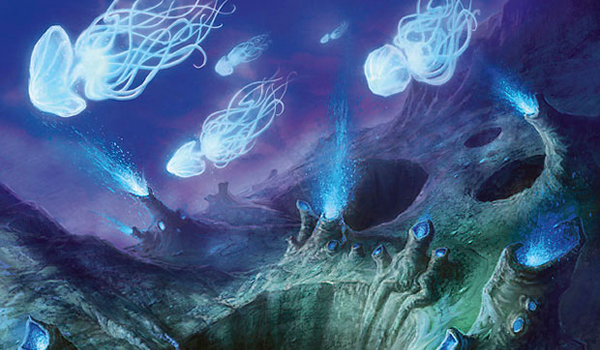
To be clear, once again, this is not an article about banning anything. I don't really care too much or do any speculating on banlist changes. Formats are what they are. I mean, if we could get Treasure Cruise back that would be great, but I aim to make the focus of my articles more pragmatic. For today's piece, I'm going to break down exactly what the Dredge deck is up to, and what we as players can do to beat it. With nine Dredge decks in the Milwaukee Open Top 32, ignoring the deck would be irresponsible.
[wp_ad_camp_1]
Knowing the Enemy
Dredge lists saw some serious fluctuations for a while, and there were somewhat varied plans and enablers. You would see Bridge from Below in some lists while being absent from others, and for a time even Hedron Crab and Vengevine were seeing fringe play. The archetype had pretty divided camps, and nothing to rally around as the consensus best build.
Then Cathartic Reunion happened. Dredge was really looking for something that could make the deck faster, though a two-mana tool with this level of power and consistency was more than enough to get everybody on the same page. No more Greater Gargadons. It's all about consistent Prized Amalgams, Bloodghasts, and Conflagrates now. There was very little deviation in Dredge lists in Milwaukee, and you can expect a Dredge opponent to be playing something close to this:
Dredge, by Kent Ketter (3rd, SCG Milwaukee Open, 10/23/2016)
This deck wants to get to work discarding its cards and milling itself as early as turn one, and to convert this into a large quantity of generally unassuming creatures very quickly. These creatures can either win the game on their own, or the deck can utilize Life from the Loam to set up large Conflagrates to kill opponents on as high as ten life. Given that it just takes one looting effect to get going and that Life from the Loam and Faithless Looting can fairly reliably facilitate at least some dredging once you start, Dredge is able to mulligan fairly aggressively and doesn't have to ask a lot of a starting hand.
For players who played during the time of Dredge in Extended, or when Dredge was a real contender in Legacy, we know what we're dealing with. In those formats, beating Dredge all came down to your sideboard plan, given how difficult it was to interact with the deck in game one. In Modern, I believe this matter to be slightly different. Hate cards certainly can crush Dredge in Modern, though there are more pre-sideboard strategies that matter.
Decks that Beat Dredge
Narcomoeba provides Dredge with blockers that can make it difficult for decks like Infect and Affinity to punch through in time, though if you're playing a deck with a fast clock that can largely ignore the combat step, you should be relatively favored against Dredge in game one. 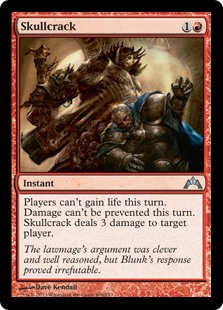 Most games that Infect wins against Dredge involve Blighted Agent, and reach is the generally going to be the name of the game for beating Dredge.
Most games that Infect wins against Dredge involve Blighted Agent, and reach is the generally going to be the name of the game for beating Dredge.
As such, it's not terribly surprising that Burn is a pretty tough matchup for Dredge. One might point to sideboard Gnaw to the Bone as an answer, though Burn is able to power through Gnaw with Skullcrack fairly consistently. The real gem for this matchup out of Dredge is Collective Brutality, and given the texture of that matchup, it's not surprising that Ketter boarded up to three copies of the Burn-crushing haymaker.
The very hard matchups for Dredge are going to be decks that aim to kill on about turn four that are more difficult to disrupt than Burn. Ad Nauseam is pretty great at interacting with Dredge while Dredge doesn't have much to punch back, and as such it wasn't terribly surprising to see Sam Jadin take 2nd in Milwaukee with the deck. Valakut decks will also generally do a pretty good job of racing Dredge, though they don't have quite as many tools as Ad Nauseam given the power of Angel's Grace and Phyrexian Unlife as Time Walk-esque effects.
Hateful Tools, and How to Use Them
For those of us not trying to play a non-interactive combo deck, it's likely that we'll be reaching for our sideboard if we want to beat Dredge. There are a lot of tools available in the format, though it's important to understand the role that they play, and how to actually utilize them to win games. The printing of Prized Amalgam has been very significant for Dredge, and not just because it gave the deck more mana-free actions. Narcomoeba enables a Dredge player to have Amalgams on the battlefield as early as turn one, and the card is eminently castable on turn three. Nessian Courser may not seem like much, but it's a significant upgrade from the Stinkweed Imp beatdown plan that Dredge used to need to go on against hate, and as such mulligaining to hate pieces is worse against Dredge than it ever has been.
Grafdigger's Cage
 Grafdigger's Cage is among the more commonly played answers to Dredge, in part because it has a textbox that also hoses Collected Company. Being findable off Ancient Stirrings is also a contributing factor. The ability to come down on turn one and turn off opposing shenanigans is very powerful, and your Dredge opponent is going to need to find some specific cards to beat a good hand with Cage.
Grafdigger's Cage is among the more commonly played answers to Dredge, in part because it has a textbox that also hoses Collected Company. Being findable off Ancient Stirrings is also a contributing factor. The ability to come down on turn one and turn off opposing shenanigans is very powerful, and your Dredge opponent is going to need to find some specific cards to beat a good hand with Cage.
That said, most of your Dredge pilots will be packing Nature's Claim and/or Ancient Grudge to deal with a potential Cage. An opening hand is not keepable merely because it has a Cage, and even though the other factors to assess seem kind of minor, they are important. Basically, when you have Cage you have to account for the medium beats of a turn-one cheated or turn-three hardcast Prized Amalgam and Narcomoeba, in addition to having something to fall back on should your Cage be destroyed. For a general rule, a five-card hand with Cage is likely something that you should always keep, but a seven card hand with Cage still needs to be generally functional.
Rest in Peace
The upside of Rest in Peace over Grafdigger's Cage is both that it actually exiles graveyards and that enchantments are a little harder to remove than artifacts. The downside is that you give your opponents more time to have already cheated creatures into play. 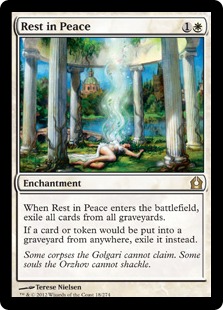 As such, opening hands with Rest in Peace have to be examined even more critically than those with Grafdigger's Cage, and if you're on the draw your Rest in Peace will sometimes be too slow to matter.
As such, opening hands with Rest in Peace have to be examined even more critically than those with Grafdigger's Cage, and if you're on the draw your Rest in Peace will sometimes be too slow to matter.
Rest in Peace is among my lesser recommended pieces of graveyard hate, and if this is the tool you're trying to employ then I strongly recommend testing post-sideboard games with the card. You may not be as happy as you thought you were with this particular piece of hate.
Relic of Progenitus
Relic of Progenitus has all of the downside of Rest in Peace and a little bit more. Dredge plays fetchlands, which makes it difficult to leverage the card without actually exiling it, and once you exile it you no longer have your hate piece in play. You can't expect Relic to win the game on its own even if your opponent doesn't have an anti-hate piece. As such, you don't see many Relics these days. Though once a maindeck card for Tron, you're much better off finding a Grafdigger's Cage with your Ancient Stirrings in the current environment.
Leyline of the Void
Leyline of the Void is great, though its particular downside is that it's pretty bad outside of being in your opening hand. That said, if you have four cards that you're looking to commit to beating Dredge, this is likely what you're looking for. 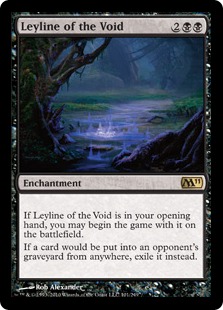 With a Leyline in your opener you can rest assured that your oponent won't be up to anything degenerate on turn one, though you do still have to be somewhat wary of three-mana 3/3s and Nature's Claim. The one-sided nature of this hate piece is also a nice boon, and the reason that Leyline is the card of choice Dredge itself uses to beat the mirror.
With a Leyline in your opener you can rest assured that your oponent won't be up to anything degenerate on turn one, though you do still have to be somewhat wary of three-mana 3/3s and Nature's Claim. The one-sided nature of this hate piece is also a nice boon, and the reason that Leyline is the card of choice Dredge itself uses to beat the mirror.
Surgical Extraction
When there were varying builds and more potential cards that matter popping out of the graveyard, Surgical Extraction was worse. Now that every Dredge list is just Amalgaming and Bloodghasting, two Surgical Extractions can close the game with little additional assistence. For Snapcaster Mage decks I am pretty big on Surgical Extraction, and it's currently what I recommend for the Grixis Delver sideboard.
The downside of Surgical is that if you only have one your opponent could just mill over Bloodghast, Narcomoeba, and Prized Amalgam to put you in a tight spot. But as long as your hand is relatively functional, a Surgical Extration in your opener is probably pretty great. It's imortant to note that you should genearlly wait for the recursive creatures to pull the trigger on Surgical, but against hands that are demonstrating some weakness it will be wise to just go for the jugular and hit their Golgari Grave-Trolls.
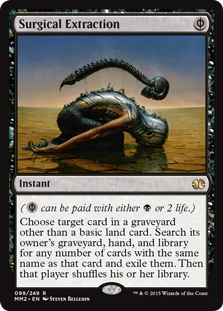 Notably, the Surgical plan leaves the door relatively open for you to get Conflagrated to death, so you can't just rest on Surgical and do nothing.
Notably, the Surgical plan leaves the door relatively open for you to get Conflagrated to death, so you can't just rest on Surgical and do nothing.
Bojuka Bog
You don't see a ton of Bojuka Bogs, though they do show up either as part of a Knight of the Reliquary package or in conjunction with Life from the Loam, usually out of Dredge itself. The strength of Bojuka Bog is that it's pretty much a freeroll if you can justify the slot, though it is slow and only has a one-time use. This card is totally fine, but isn't exactly a haymaker. If you expect Dredge mirrors then having it in addition to your Leylines is reasonable, and if you can convince yourself to play Knight of the Reliquary then it's a great piece of utility. But the value that it adds is relatively minor, and won't generally matter in the absense of other hate.
Anger of the Gods
People ask me somewhat often about putting Anger of the Gods in my Delver sideboard, which just seems insane to me. You beat Dredge by messing up their graveyard and killing them before they can do anything about it. In a creature deck, Anger just kills your own clock. This is not a dedicated hate card, and I only like it if it conveniently falls on your curve en route to killing the Dredge player. For example, if I were playing a Valakut deck I would be pretty happy to take a turn off to Anger away some creatures that my Dredge opponent found and then Primeval Titaning or Scapeshifting them to death shortly after. Unless my deck is dedicated control or combo deck that can easily take a turn off to Anger, I'm not really interested in it for the Dredge matchup.
It's on the Community Now
With the results of Milwaukee, the Dredge players have put the ball in our court. Now we find out how beatable the deck is, and how warping the deck is if it is beatable. I'm curious to see how things shake out, as it would be pretty unfortunate if Golgari Grave-Troll ended up returning to the banlist. There are definitely tools available for beating Dredge—just make sure you pick the right one.
Thanks for reading.
-Ryan Overturf
@RyanOverdrive




I think Rakdos Charm is a great option. It removes their graveyard at instant speed and also improves your affinity matchup.
I agree. I’ve been testing Rakdos Charm to great effect.
Ensnaring Bridge also happens to be a really good answer to the deck, especially paired with 4x Surgical Extraction. Oh how i love Lantern! Seems like it may again be Lantern’s time to shine.
I like to play rakdos charm in my maindeck in BR burn. Modes #1 and (with gargadon gone now) #3 work wonders on dredge, Modes #2 and (as long as there no ravager) #3 work on affinity, Mode #3 hoses elves, bant eldrazi, kiki chord, and helps significantly on soul sisters. I think that if you can fit it in the maindeck you can defeat most decks on game one that have a huge game one advantage. My burn deck already has enough targeted removal (both bolts, blaze, and anger) to not worry too much about game one infect.
is Bojuka Bog playable in Tron? It can be tutored up pretty easily. Maybe it could replace Ghost Quarter out of the sideboard?
I assume it’s just going to be less good than Grafdigger’s Cage. A big part of your game plan is Wurmcoil Engine and/or Ugin, so getting non-Tron lands seems quite poor.
If I were still playing Grixis Delver, Rakdos charm would be my go to card. At least 2 modes are relavent. Early, if they flip 3 amalgums and can bring them back, just wait for them to trigger then exile them. Amalgums are just about the only way dredge beats Grixis.
For everything not running black red, I like surgical extraction. It let’s you pin point which ever card is going to beat you. Low on life, exile conflagrate. Again, they flip a few amalgums, boom, gone. And as long as you have 2 life, it’s free.
Soul Sisters I think already has a pretty good dredge matchup because they keep bringing stuff back, but surgical seals it IMO because the only thing that can beat you is conflagrate(I did get golgari charmed once but i think that was a fluke as it was the perfect card at the perfect time).
Remember, dredge is a meta matchup. Modern has more than enough GY hate to easily make it unplayable. The thing it, the more you dedicate to beat it, the weaker you are to other decks.
Thanks for making such a strong case for Surgical against Dredge. I found your four SB copies in Grixis Delver pretty dubious last time around but am sold now, at least on a pair.
In my Mardu Nahiri list 3x Rest In Pizza and 3x Anger of the Gods come in seeing as my turn 2 Wall of Omens conveniently could care less about Anger of the Gods; its a blow out 🙂 I imagine the Jeskai versions could probably implement the same side board options depending on their main board creature package. Not to mention AotG is also a blow out for bushwhacker zoo decks ;P
Just so you know, as a Dredge player for quite a while now: One of the toughest matchups we have are tron decks, RG a little more than monoU. Just because of ugin, wurmcoil and the family. Also, banning golgari grave troll would be what i would like to happen if we get something banned. Sadly, i keep looking at their ban history and i keep thinking they are looking at conflagrate, since it helps us close maybe a little bit too many games, and we can use it to kill a little bit too many strategies (creature based format, duh…). Very nice article, i hope you guys read it three or four times so that we get sided out of the 10% meta and i can keep playing this deck that i love so much, even with a slightly less visible winrate :p
No love for Tormod’s Crypt? I mean, as far as low-impact solutions go, it’s hard to beat a 0 mana card that boards into any deck. It’s not as resilient, but as far as just “applying hate without hurting your own gameplan” it’s hard to top (Not to mention Lantern Control, Tron, and Eldrazi can fetch it with stirrings, and it even helps Lantern Control get Metalcraft running)
I’m building a more rogue deck that beats all tier 1 decks more than 70% of the time, except for burn and jund which are at 50%.
I use 4 auriok champion, 2 stillmoon cavalier, 3 ensnaring bridge, and 2 leyline of the void.
All of it in the mainboard.
At an earlier stage I played 3 oona’s prowler, which actually enabled dredge to speed up quite a lot, so dredge is beatable even for the fringe rogue decks…